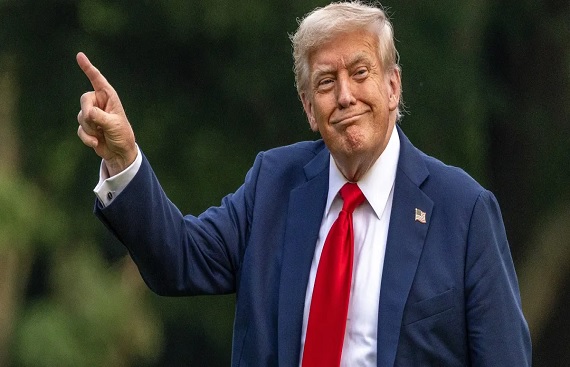RBI Faces Rate Dilemma as Trump's Tariff Shock Clouds Outlook
By
siliconindia | Tuesday, 05 August 2025, 12:43 Hrs

- Trump's 25% tariff on Indian goods has clouded growth prospects, prompting some economists to expect a rate cut from the RBI.
- With inflation at 2.1% well below the 4% target there's room for easing, though many still expect a hold.
- A rate cut could weaken the rupee further; markets also await clarity on RBI’s liquidity management approach.
The Reserve Bank of India (RBI) faces a pivotal interest rate decision today, with global trade tensions and a subdued inflationary environment setting the stage for a potentially dovish move. Market participants are on high alert as the US President Donald Trump’s recent imposition of 25% tariffs on a range of Indian goods has introduced fresh uncertainty into India’s economic landscape, complicating the RBI’s policy calculus.
Governor Sanjay Malhotra is set to announce the central bank’s decision at 10 a.m. in Mumbai, with economists and investors split over whether the RBI will continue holding the benchmark repurchase rate steady at 5.5% or opt for a preemptive rate cut to cushion the economy. Until the tariff shock, most analysts had expected no policy change following the governor’s cautious tone in the June policy meeting. A Bloomberg survey of 34 economists found that 23 still expect the RBI to hold rates this week, although a growing minority now anticipates a 25-basis-point cut.
Among those expecting a cut are Soumya Kanti Ghosh of State Bank of India, who was the only economist to accurately predict the RBI’s larger-than-expected rate cut in June, and Dhiraj Nim of Australia & New Zealand Banking Group. They argue that with inflation sitting at just 2.1% in June its lowest level in over six years and well below the RBI’s 4% medium-term target the central bank has sufficient room to ease policy. Ghosh emphasized that a front-loaded cut would boost spending ahead of the festive season and support credit growth, especially as inflation is expected to remain under control through the fiscal year.
However, not all economists agree. Aastha Gudwani of Barclays Bank believes the RBI will likely take a wait-and-watch approach, arguing that the impact of previous rate cuts is still being transmitted into the economy and trade negotiations with the US are still unfolding. According to Gudwani, the central bank might choose to hold rates this time, reserving its tools for more pressing uncertainties in the future.
Adding to the complexity of the RBI’s decision is the weakening Indian rupee, which remains near its record low seen earlier this year. A rate cut could place further downward pressure on the currency, making Indian assets less attractive to global investors and increasing the risk of capital outflows. With the US Federal Reserve maintaining its policy rates, there is little incentive for emerging markets like India to aggressively ease monetary policy at this point, analysts say.
Economic indicators present a nuanced picture. While inflation has remained below the RBI’s target for five consecutive months and a good monsoon has supported agricultural activity, the overall growth outlook remains fragile. Analysts warn that Trump’s tariff move far steeper than those imposed on Asian peers such as Vietnam and Indonesia could shave as much as 30 basis points off GDP growth. As a result, many expect the RBI to revise down its growth and inflation forecasts during this policy review. Goldman Sachs economist Santanu Sengupta predicts inflation will average around 3% for the fiscal year, down from the RBI’s previous projection of 3.7%.
Market participants are also closely watching the central bank’s position on liquidity management. The RBI recently drained short-term liquidity following its June CRR (Cash Reserve Ratio) cut, a move that surprised bond traders and sent overnight borrowing rates above the policy rate. The central bank later had to inject short-term funds to stabilize the market. With excess liquidity currently at Rs 3.3 trillion and more cash expected to enter the system in the coming months, traders are eager for the RBI to clarify its liquidity framework and ensure effective transmission of its rate decisions.
Interest rate swap markets currently reflect expectations of a hold in the August meeting, with a marginal chance of a rate cut in October. India’s 10-year benchmark bond yield has edged up by about 10 basis points over the last two months as traders adjust their expectations based on shifting policy cues and liquidity actions. Alok Singh, CIO at Bank of India Investment Managers, noted that if core inflation continues to moderate, bond yields may soften, particularly in the medium and long-term segments. However, any hawkish commentary or fresh external shocks could push yields higher again.
Today’s announcement will be a key indicator of how the RBI plans to navigate the ongoing turbulence in global trade, financial markets, and domestic demand. With both inflation under control and global uncertainty rising, Governor Malhotra’s policy message will be scrutinized for signs of the central bank’s future course. Whether the RBI opts to hold firm or deliver another rate cut, the decision is poised to have a significant impact on credit conditions, investor confidence, and the overall momentum of the Indian economy heading into the latter half of the fiscal year.
